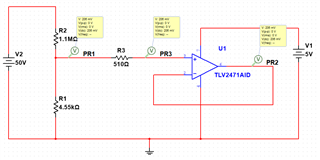Hello, I would like to ask some questions about TLV2471, I want to measure the high voltage V2(range is 5-50VDC),so I used a resistor divider to lower the voltage V2,then connect it to a voltage follower(TLV2471 used), the simulation schematic as shown in the figure.
When I do the actual test, I find the voltage of R1 is 0.219VDC(V2 is 50V), It is different from the calculate value and simulation result (0.206V), Because the input impedance of volage follower is very high, I think it will not affect the soure voltage, I wonder what caused the problem? Thank you very much.
In additon I have another question about R3, I found there is a serise resistor at the non-invert input of OPA in some design, What's the fuction of this resistor? Thanks.



